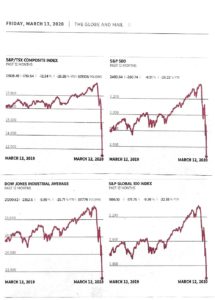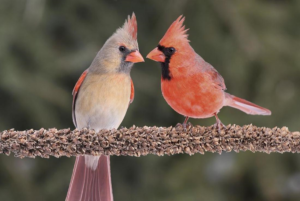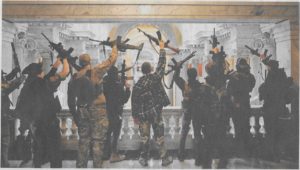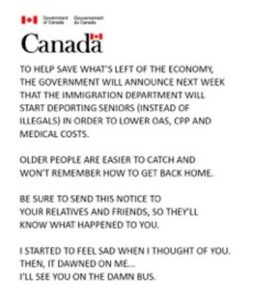Old is New
April 3: A couple of days ago, I encountered a strange new world while going to the grocery store. People were quietly waiting outside the doors, stationed the mandatory 2 meters apart. I’m sure that many of you have had a similar experience. As we all navigate our way through the COVID19 epidemic, I have heard many people make comparisons to war: we are mobilizing to face a common enemy; industry is being conscripted to produce materials we need to continue the fight; people are being asked to sacrifice comfort, personal freedoms and perhaps their very lives for the “common good”.
 While the analogy to war may be apt, most of us have no direct experience of war beyond the stories of our parents to draw upon. But as I thought about it a bit more I realized that there are perhaps parallels to the level of anxiety many of us felt during the 1962 Cuban Missile Crisis.
While the analogy to war may be apt, most of us have no direct experience of war beyond the stories of our parents to draw upon. But as I thought about it a bit more I realized that there are perhaps parallels to the level of anxiety many of us felt during the 1962 Cuban Missile Crisis.
I was 12 years old and in Grade 7 at Deer Park School. I was old enough to understand some of the issues that triggered the crisis and, while I knew that it was “a big deal”, I think that I was young enough that I didn’t pay much attention. In time, the ominous newspaper headlines, TV broadcasts and the generalized angst I felt in the adults around me began to permeate my thoughts. Even as relatively young children, I think that, as the crisis deepened day-by-day, we all knew on some level that we would not survive an attack if it were to happen.
In preparation for a possible attack, the government began testing the air raid sirens. This seemed to happen at random intervals and underscored in me the idea that an attack could happen at any time and without warning. Preparations and drills started at the school and I’m pretty sure that my parents were making ready at home as well. I recall the anxiety I felt if I was separated from them for very long. I think we all realized that if an attack happened, we wouldn’t be able to run home from school to Mum and Dad. We would likely face the consequences alone.
 As students in Grade 7, we were in a room on the second floor of the school. When the alarm was sounded, we left our classroom and went down to the ground floor hallway (actually a 1/2 below grade level) where we were told to sit with our backs against the wall. One of the students asked a teacher whether there was a basement level, and whether we wouldn’t be safer down there. She replied that there was a basement, but if there was an attack, the swimming pool would flood the basement and we would all drown. Even as 12-year-old’s we clearly understood that an attack would mean the end of us, either by drowning or being blasted to smithereens.
As students in Grade 7, we were in a room on the second floor of the school. When the alarm was sounded, we left our classroom and went down to the ground floor hallway (actually a 1/2 below grade level) where we were told to sit with our backs against the wall. One of the students asked a teacher whether there was a basement level, and whether we wouldn’t be safer down there. She replied that there was a basement, but if there was an attack, the swimming pool would flood the basement and we would all drown. Even as 12-year-old’s we clearly understood that an attack would mean the end of us, either by drowning or being blasted to smithereens.
Over the next 14 days or so, the tensions ratcheted up. The crisis began to feel like standing too close to the tracks as a freight train passes. And just like the train ends, Russia blinked, and the crisis ended on October 28. Life returned to “normal”. I think for many of my generation it was a defining moment that introduced us to “global politics” and the realization that so much of what happened around us had huge consequences that were totally beyond our control.
Much of that feels quite familiar in a COVID19 environment. News and television reports highlight the most recent bad news. Things are changing rapidly and seemingly at random. We’re told to take measures to prepare for the worst, and there is a sense of inevitability as the pandemic spreads. While many people – like me – perhaps naively believe that there is a relatively low chance of contracting the disease, there is a level of anxiety in our society that I have not seen since ’62. Every conversation begins with 20 minutes of discussion about the latest developments or miracle cures or how to sanitize your groceries. It’s relentless.
In the end, the pandemic will end. Unlike the Cuban Missile Crisis which ended on a specific date, the pandemic is likely to ebb and flow for a while (perhaps as long as 2 years). Although changed forever in many ways, life will return to normal – whatever that might be. In the meantime, pack your patience, and keep your distance.
Glass Half-full
March 20: I have come to realize that I am fundamentally an optimist. I tend to default toward believing that things will work out for the better; if left to their own devices, people will do the right thing more often than not.
So it was with some hopefulness that I thought about the lifting of the rail blockades a few weeks back. After a protracted and wrenching stand-off, there appeared to be agreement between the First Nations, the Feds and the companies involved on a way to remove the blockades and move forward.
It seemed that the Feds were finally acknowledging the sovereignty of the First Nations and the need to have their agreement for any major works within their territories. This process seemed to be – and I hate to use the word – a significant step toward reconciliation. The First Nations seemed to accept that they needed to get their act together and come to a common position in negotiations with peers. It also seemed that there was the real possibility that they would come to the table as partners in resource development with major corporations, and finally secure access to sustainable income and a way to participate in the larger economy.
There remained issues at the Provincial level – this is Canada after all – but it seemed that the oil and gas market was shifting just enough that Alberta was being forced to confront the fact that their carbon-based economy couldn’t last forever.
Then COVID19 intervened. For the last few weeks, there has been news of nothing else. It has sucked all the air out of the room and become, as Cathal Kelly said in the Globe, a loud and constant buzzing in the back of your brain. Almost simultaneously, Saudi Arabia and Russia started a price war over oil. This, along with the forced shut down of significant parts of the economy due to the virus, has hammered the global economy. We may be on the brink of a global recession. Oil prices have plummeted to their lowest level in decades. Alberta crude, already in trouble at $32 a barrel, is today trading near $9.
So where does this litany of woe leave an optimist like me ? As an optimist, I have to assume that the Feds and the First Nations are at least continuing to think about hammering out an agreement around resource development and sovereignty (among other critical issues) while they also grapple with the virus. I am hopeful that the First Nations respect for the land will imbue future resource development with a more sustainable perspective. I hope that, as partners, those communities can begin to participate more fully and more equally with the rest of the country.
I also hope that forcing the Federal and Provincial governments to deal with the COVID19 virus and the plunging economy in a coordinated fashion will dispel some of the regional hostility that was apparent even a few weeks ago. There has to be an understanding that we are all in this together and that we are more alike than different. Perhaps taking some of the “politics” off the table will turn out to be a good thing.
As well, I am hopeful that the extremely low oil prices and the latest round of financial assistance this crisis has spawned will begin a transition away from oil extraction and toward a more sustainable future. The Feds are proposing to fund the clean-up of orphaned wells, of which there are many thousands across the country. Hopefully, Alberta will also find ways to provide employment for oil field workers in alternative energy environments.
Finally, on the global stage, perhaps the global viral epidemic has cost China enough “face” that they will be chastened for at least a while in their global ambitions. Given the interdependence of our economies and the battle against COVID 19, perhaps channels have now been opened that will allow us to see each other as residents of the world, rather than members of opposing camps.
There’s so much going on these days that it’s hard to keep track of the latest (correct) information. In the face of so much adversity, it’s often difficult to be optimistic and hopeful for our future, yet I try. If I squint at these problems just right, I begin to see opportunity. I can only hope that there are others out there who feel the same way, and that major beneficial change can come from our current struggle.
Thanks, Don
March 12: A small group of friends have been kidding each other over the years about our investing acumen. Many years ago, a couple of them found a small drug company that they felt certain to be on the verge of announcing a major breakthrough. With much anticipation they bought in and – of course – within days the company was bust. I contributed to the litany on woe by buying Nortel at the absolute apogee of it’s climb up the markets. I was told by everyone that I spoke to – including the brokers I used – that it was safe and would not lose money. Within weeks it was headed down and I was told to hang on to it: “It will recover in time.” We know how that ended. Obviously, the collapse of Nortel was entirely my fault.

So it was that last week I decided to invest a very small sum in and ETF that tracked the TSX 60. The market had wobbled a bit and had been down for a few days so I thought that it might be time to put some money in “near the bottom”. The very next day it dropped 30% so obviously I had not lost my touch with the markets. Like most people, I was not amused, but I was comforted by the thought that things will ultimately return “to normal” and markets should recover over time.
Then that moron in the White House went on national TV to reassure people. The markets fell off a cliff the moment he began speaking in the Oval Office and had their worst downturn in 80 years. I thought I was good at wrecking the market but perhaps he’s right: he is a genius. He takes destruction of value to another level entirely.
Anyway, it is what it is. I am not alone. Others have far more at stake, and are suffering much more dire consequences than me. In time, things will return to normal – whatever that turns out to be. In the meantime, stay healthy. Wash your hands. Be good to each other.
Seven Degrees
February 22: Over the last few days, daily temperatures have begun to reach mid- to high-single digit territory. Daylight is more intense and now extends well past 6 PM. If you can find a spot out of the wind, the sun is noticeably warmer. Near our home there is a row of tiny green shoots poking out of the soil; the buds on the Saucer Magnolia at the end of the street are engorged and covered with tender fuzz. Squirrels on the courtyard are scrambling around gathering mouthfuls of leaves as they prepare their nests for this years’ litter of pups which will be born in the next few weeks.
 It was the familiar call of the Cardinals that alerted me to all this activity. I really should have expected to hear it because they started singing during the same week last year. Cardinals are very industrious and their call is well known; a long and descending phew followed by repeated whit, whit, whit notes. During the summer I often hear them before dawn – usually before sunrise and before those lazy Robins are half-awake. When I lived in the Lakeshore, this was also the time when Red-winged Blackbirds returned and began nesting for the season. Unlike Cardinals, they are migratory and among the first to return to face late blizzards and still-freezing temperatures.
It was the familiar call of the Cardinals that alerted me to all this activity. I really should have expected to hear it because they started singing during the same week last year. Cardinals are very industrious and their call is well known; a long and descending phew followed by repeated whit, whit, whit notes. During the summer I often hear them before dawn – usually before sunrise and before those lazy Robins are half-awake. When I lived in the Lakeshore, this was also the time when Red-winged Blackbirds returned and began nesting for the season. Unlike Cardinals, they are migratory and among the first to return to face late blizzards and still-freezing temperatures.
While the birds are interesting to many including myself, all of the signs of Spring are quite predictable. Bulbs sprout, blossoms bloom and animals nest on a regular schedule if we are attuned enough to simply see them happening. Left to her own devices Mother Nature is very resilient and will continue to do what she does best in spite of our interference. So my advice, for what it’s worth, would be to get out there and enjoy the rebirth happening all around us. Keep your eyes and ears open to the changing seasons; a wonderous pageant is unfolding.
February 27: Then again …..
https://www.allaboutbirds.org/guide/Northern_Cardinal/overview
https://www.allaboutbirds.org/guide/Red-winged_Blackbird
Bang,bang. Shoot,shoot.

February 1: When I first saw this picture in the Globe and Mail this morning I thought it was of a militia somewhere in the middle east. I was wrong: It turned out to be a Second Amendment demonstration inside the capital building in Frankfort, Kentucky. Clearly, this is not a gathering of thoughtful and concerned citizens raising a philosophical argument about gun control. It’s about intimidation and the threat of possible consequences.
I’ve seen video of some gun ownership advocates arguing that this type of weapon is really only used for target practice or shooting deer. They must have some seriously aggressive deer in Kentucky if you need that sort of power to bring them down. Whatever their intended use, advocates always seem to speak in a menacing and vaguely threatening tone, as if to say “I have a gun and I’m not afraid to use it ….” Against you.
Until recently, I believed that Canada had a different frame of mind when it came to gun control. Now, I’m not so sure. I recently watched a TV report from western Canada which included interviews with several reps from the gun ownership lobby and the parallels in argument and language with their American counterparts was striking. I found it extremely worrisome because, unlike the United States, we have no “right to bear arms”. It’s a privilege.
At one time, long guns were registered. But, in what was clearly a move that pandered to rural voters, the long-gun registry was dismantled by our former Glorious Leader Harper, thereby removing one tool that Police might have used to track dangerous weapons. Roughly 7.5 million weapons were removed from government records. I suspect that, here in Canada, relatively few citizens are killed by rifles or shot guns. So arguably at least, perhaps there was not a lot to gain from registering these weapons. Farmers and hunters have a legitimate reason to arm themselves; life here in the city is different.
In Toronto last night, 3 people were shot to death at a house party. Little is known as I write this. The victims are all in their early 20’s. They were at a rented Airbnb when things went sideways. For whatever reason, someone felt sufficiently aggrieved to haul out a pistol(s) and try to settle the score. Clearly, the guns in question were not intended for hunting or target practice; I suspect they were “rented” from organized crime (like gangs) and smuggled into our country from the USA.
The Toronto Police Service reported 492 shootings last year resulting in 44 deaths and 246 people injured – that’s roughly 10 shootings a week with at least 5 people wounded or killed. The Police suggest that if we are not involved with gangs or crime, the chances of being a victim are slim, yet I am now seeing reports of “unintended victims” with greater frequency. Mayor Tory has been pushing for a handgun ban for some time, and the Federal parties have both been ragging the puck for far too long. The gun lobby would suggest that banning handguns would only penalize law-abiding owners, and to an extent, I understand that argument. That said, I think the time has come for us to do something about the spread of weapons in this country. I don’t ever want to see an armed militia on Parliament Hill. We are better than that.
The Globe and Mail weighs in:
https://www.theglobeandmail.com/opinion/editorials/article-on-gangs-and-guns-politicians-are-missing-the-point/
Newfoundland
January 20: The National on the CBC showed the following item by Mark Critch discussing the recent blizzard in Newfoundland. Perhaps I am a sentimental old goof, but I found it humorous and moving. Maybe we all need to be a bit more like our friends in Newfoundland.
https://www.cbc.ca/news/thenational/an-ode-to-the-newfoundland-storm-mark-critch-1.5434216
Re-start
January 8: This morning I ran 5.4 km. It’s the fourth time I’ve run since Christmas and it’s not a lot when I consider that I was running 20 km a crack last year. But it’s a start back toward some level of fitness, and certainly better for me than an equal amount of time in front of the idiot box ( TV or computer – take your pick ). I ran through the cemetery as I frequently do. I find it quiet, safe and it provides a contemplative, if slightly melancholy place to reflect on things as I run. Mostly, though, it was just nice to have some time to myself to reflect on the chaos of the last few months.
Frequent reader(s) will know that I returned from Europe at the end of September. I had 4 days to pack the place up and get that moved to our new home just down the walk from my apartment. Kate was in a somewhat worse position because she had 20 years or so of accumulated possessions to sort through and decide whether to move them, store them, or recycle them. In the midst of that exercise, her time with the Ivey Foundation ended – something that we did not expect but which has worked out to be quite beneficial for both of us.
 After she moved, there were many days spent “setting up house”. As anyone who has done this recently will tell you, it’s not as easy as it should be. Each of us is used to having certain things in certain places, and deviating from that means compromises or choices which need to be worked through. We spent a good long time doing this, and then realized that we still had to get ready for Christmas.
After she moved, there were many days spent “setting up house”. As anyone who has done this recently will tell you, it’s not as easy as it should be. Each of us is used to having certain things in certain places, and deviating from that means compromises or choices which need to be worked through. We spent a good long time doing this, and then realized that we still had to get ready for Christmas.
Kate is a shopper. I say that with some admiration because I am not. She enjoys thinking about what gift would be appropriate for each person on her list, and it can be a long list with sisters and in-laws and nieces and nephews and children. Then there is the process of tracking down the gift, getting it wrapped (also with great care and attention), and delivering it to the recipient. My aimless wandering through Winners and the LCBO, and stuffing the selected items in bags, are clearly not going to cut the mustard next year.
Our expanded circle of friends generated what was – to me at least – a lengthy list of social commitments in December which included a gala concert, three group get-togethers, four dinners at home and two at others’ homes, two full-on Christmas dinners (on the same day, of course), two brunches, one celebration of life out of town, and thankfully, one quiet New Year’s dinner at home. If there is an element of the holiday season that I enjoy more than any other it is the opportunity to get together with people to begin or reinforce friendship, and to share good-will and happiness. These events didn’t disappoint. That said, it was a bit daunting for me – a natural recluse – to be in so many social situations in such a short time.
And now things have begun to feel more “normal” – whatever that might be. Given everything that has happened over the last couple of months, it honestly feels like Kate and I have not really had a routine time since we moved. It feels like now is the right time to pay attention to our lives together and get back in the groove on enjoying each others’ company. Maybe even do some running in the cemetery….
And Further
January 2: As set out in the previous post, I had my credit cards and identity stolen in late November. In mid-December I received a letter from TD saying that they had received my “claim of disputed transactions” and that they had concluded their investigation. Regrettably, my claim had been denied….
I found this to be interesting for many reasons: Beyond speaking to their representative when the cards had been stolen, I’d not made any claim or disputed any transactions with them. Their rep said that the charges that had been processed would not be charged to me. They were obviously fraudulent. I did go to the Police of my own volition, but that report, to the best of my knowledge, had not been sent to TD, so I have no idea what their “investigation” included.
The TD letter invited me to call their customer service number if I was upset that my claim had been denied ( it did, seriously… ) or if I had further information that “you think we should be aware of….”. I called on 4 successive days and waited a total of 2 hours and 35 minutes without speaking to an actual human being. ( Cursing out the recorded voice saying that “your call is important to us”, doesn’t count…. ) I now see why their corporate identity includes a large green chair. You need one so you can wait comfortably for someone to pick up the phone. I finally resorted to writing a letter to the VP in charge and had the local branch FAX it to her office.
In reply, Stephanie from TD called me and we had a pleasant chat. She finally got the sort of detail I might have expected from an actual “investigation”: things like “Where were you when this happened…?” The jury is still out on what I will have to cover from the expenses racked up by the thieves. But the one thing she did say that I found truly surprising is that all of the purchases were made with my PIN. Whoever had the cards also had the ability to read them to extract the PIN and make purchases within minutes of having stolen them. The PIN was entered perfectly the first time….
Technology marches on, nowhere more so than in crime, I suspect. I was naïve to much of this sort of thing, so the whole process has been an education for me. I mention all of this not for sympathy (of course), but in the hope that you may avoid a similar fate in the new year.

